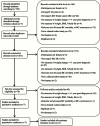Weight Gain After Breast Cancer Diagnosis and All-Cause Mortality: Systematic Review and Meta-Analysis
- PMID: 26424778
- PMCID: PMC4715249
- DOI: 10.1093/jnci/djv275
Weight Gain After Breast Cancer Diagnosis and All-Cause Mortality: Systematic Review and Meta-Analysis
Abstract
Background: Overweight and obesity are associated with breast cancer mortality. However, the relationship between postdiagnosis weight gain and mortality is unclear. We conducted a systematic review and meta-analysis of weight gain after breast cancer diagnosis and breast cancer-specific, all-cause mortality and recurrence outcomes.
Methods: Electronic databases identified articles up through December 2014, including: PubMed (1966-present), EMBASE (1974-present), CINAHL (1982-present), and Web of Science. Language and publication status were unrestricted. Cohort studies and clinical trials measuring weight change after diagnosis and all-cause/breast cancer-specific mortality or recurrence were considered. Participants were women age 18 years or older with stage I-IIIC breast cancer. Fixed effects analysis summarized the association between weight gain (≥5.0% body weight) and all-cause mortality; all tests were two-sided.
Results: Twelve studies (n = 23 832) were included. Weight gain (≥5.0%) compared with maintenance (<±5.0%) was associated with increased all-cause mortality (hazard ratio [HR] = 1.12, 95% confidence interval [CI] = 1.03 to 1.22, P = .01, I(2) = 55.0%). Higher risk of mortality was apparent for weight gain ≥10.0% (HR = 1.23, 95% CI = 1.09 to 1.39, P < .001); 5% to 10.0% weight gain was not associated with all-cause mortality (P = .40). The association was not statistically significant for those with a prediagnosis body mass index (BMI) of less than 25 kg/m(2) (HR = 1.14, 95% CI = 0.99 to 1.31, P = .07) or with a BMI of 25 kg/m(2) or higher (HR = 1.00, 95% CI = 0.86 to 1.16, P = .19). Weight gain of 10.0% or more was not associated with hazard of breast cancer-specific mortality (HR = 1.17, 95% CI = 1.00 to 1.38, P = .05).
Conclusions: Weight gain after diagnosis of breast cancer is associated with higher all-cause mortality rates compared with maintaining body weight. Adverse effects are greater for weight gains of 10.0% or higher.
© The Author 2015. Published by Oxford University Press. All rights reserved. For Permissions, please e-mail: journals.permissions@oup.com.
Figures






Comment in
-
RE: Weight Gain After Breast Cancer Diagnosis and All-Cause Mortality: Systematic Review and Meta-Analysis.J Natl Cancer Inst. 2016 Mar 1;108(4):djw023. doi: 10.1093/jnci/djw023. Print 2016 Apr. J Natl Cancer Inst. 2016. PMID: 26933008 Free PMC article. No abstract available.
-
Response.J Natl Cancer Inst. 2016 Mar 1;108(4):djw024. doi: 10.1093/jnci/djw024. Print 2016 Apr. J Natl Cancer Inst. 2016. PMID: 26933009 No abstract available.
References
-
- American Cancer Society. Cancer Facts & Figures 2013. In. Atlanta, GA; 2013.
-
- Society AC. Breast Cancer Facts & Figures 2013–2014. In. Atlanta; 2013.
-
- Howlader N, Noone AM, Krapcho M, et al. SEER Cancer Statistics Review, 1975–2010, National Cancer Institute. In: Bethesda, MD: National Cancer Institute; 2013.
-
- Niraula S, Ocana A, Ennis M, et al. Body size and breast cancer prognosis in relation to hormone receptor and menopausal status: a meta-analysis. Breast Cancer Res Treat. 2012;134( 2):769–781. - PubMed
Publication types
MeSH terms
Grants and funding
LinkOut - more resources
Full Text Sources
Other Literature Sources
Medical

